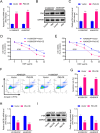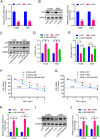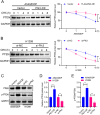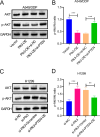Plk3 Enhances Cisplatin Sensitivity of Nonsmall-Cell Lung Cancer Cells through Inhibition of the PI3K/AKT Pathway via Stabilizing PTEN
- PMID: 38434880
- PMCID: PMC10905570
- DOI: 10.1021/acsomega.3c07271
Plk3 Enhances Cisplatin Sensitivity of Nonsmall-Cell Lung Cancer Cells through Inhibition of the PI3K/AKT Pathway via Stabilizing PTEN
Abstract
Polo-like kinase 3 (Plk3) is involved in tumor development with a tumor suppressive function. However, the effect of Plk3 on the chemoresistance remains unclear. It has been documented that activation of the PI3K/AKT signaling pathway by PTEN loss significantly enhances chemoresistance in nonsmall-cell lung cancer (NSCLC). This study aims to evaluate the PTEN regulation by Plk3 and identify targets and underlying mechanisms that could be used to relieve chemoresistance. Our results showed that silencing Plk3 reduced PTEN expression and activated PI3K/AKT signaling by dephosphorylating and destabilizing PTEN in NSCLC cells. Reducing Plk3 expression promoted drug resistance to cisplatin (DDP), while overexpressing Plk3 promoted DDP sensitivity. However, these effects were attenuated when MK2206, a PI3K/AKT inhibitor, was applied. In conclusion, upregulation of Plk3 sensitized NSCLC cells toward DDP, which provides a potential target to restore DDP chemoresponse. We provided novel evidence that the PTEN/PI3K/AKT signaling pathway could be regulated by Plk3 through phosphorylation of PTEN and highlighted the critical role of Plk3 in the DDP resistance of NSCLC.
© 2024 The Authors. Published by American Chemical Society.
Conflict of interest statement
The authors declare no competing financial interest.
Figures





Similar articles
-
YTHDC1 positively regulates PTEN expression and plays a critical role in cisplatin resistance of bladder cancer.Cell Prolif. 2023 Jul;56(7):e13404. doi: 10.1111/cpr.13404. Epub 2023 Apr 17. Cell Prolif. 2023. PMID: 37070134 Free PMC article.
-
Knockdown of KLF5 suppresses hypoxia-induced resistance to cisplatin in NSCLC cells by regulating HIF-1α-dependent glycolysis through inactivation of the PI3K/Akt/mTOR pathway.J Transl Med. 2018 Jun 14;16(1):164. doi: 10.1186/s12967-018-1543-2. J Transl Med. 2018. PMID: 29898734 Free PMC article.
-
Pentraxin 3 acts as a functional effector of Akt/NF-κB signaling to modulate the progression and cisplatin-resistance in non-small cell lung cancer.Arch Biochem Biophys. 2021 Apr 15;701:108818. doi: 10.1016/j.abb.2021.108818. Epub 2021 Feb 19. Arch Biochem Biophys. 2021. PMID: 33617838
-
Polo-like kinase 3, hypoxic responses, and tumorigenesis.Cell Cycle. 2017;16(21):2032-2036. doi: 10.1080/15384101.2017.1373224. Epub 2017 Sep 21. Cell Cycle. 2017. PMID: 28857653 Free PMC article. Review.
-
Progress in targeting PTEN/PI3K/Akt axis in glioblastoma therapy: Revisiting molecular interactions.Biomed Pharmacother. 2023 Feb;158:114204. doi: 10.1016/j.biopha.2022.114204. Epub 2023 Jan 4. Biomed Pharmacother. 2023. PMID: 36916430 Review.
Cited by
-
Regulation of cisplatin resistance in lung cancer by epigenetic mechanisms.Clin Epigenetics. 2025 Aug 24;17(1):145. doi: 10.1186/s13148-025-01961-6. Clin Epigenetics. 2025. PMID: 40851017 Free PMC article. Review.
-
PLK3 weakens antioxidant defense and inhibits proliferation of porcine Leydig cells under oxidative stress.Sci Rep. 2025 Jan 21;15(1):2612. doi: 10.1038/s41598-025-86867-2. Sci Rep. 2025. PMID: 39837970 Free PMC article.
References
LinkOut - more resources
Full Text Sources
Research Materials
